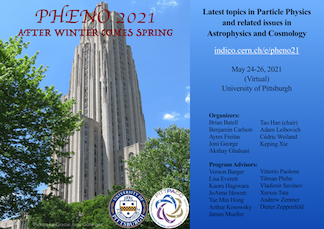Speaker
Description
We present a model of radiative neutrino masses which also resolves anomalies reported in $B$-meson decays, $R_{D^{(\star)}}$ and $R_{K^{(\star)}}$, as well as in muon $g-2$ measurement, $\Delta a_\mu$. Neutrino masses arise in the model through loop diagrams involving TeV-scale leptoquark (LQ) scalars $R_2$ and $S_3$. Fits to neutrino oscillation parameters are obtained satisfying all flavor constraints which also explain the anomalies in $R_{D^{(\star)}}$, $R_{K^{(\star)}}$ and $\Delta a_\mu$ within $1\, \sigma$. An isospin-3/2 Higgs quadruplet plays a crucial role in generating neutrino masses; we point out that the doubly-charged scalar contained therein can be produced in the decays of the $S_3$ LQ, which enhances its reach to 1.1 (6.2) TeV at $\sqrt s=14$ TeV high-luminosity LHC ($\sqrt s=100$ TeV FCC-hh). We also find that the same Yukawa couplings responsible for the chirally-enhanced contribution to $\Delta a_\mu$ give rise to new contributions to the SM Higgs decays to muon and tau pairs, with the modifications to the corresponding branching ratios being at (2--6)\% level, which could be tested at future hadron colliders, such as HL-LHC and FCC-hh.

